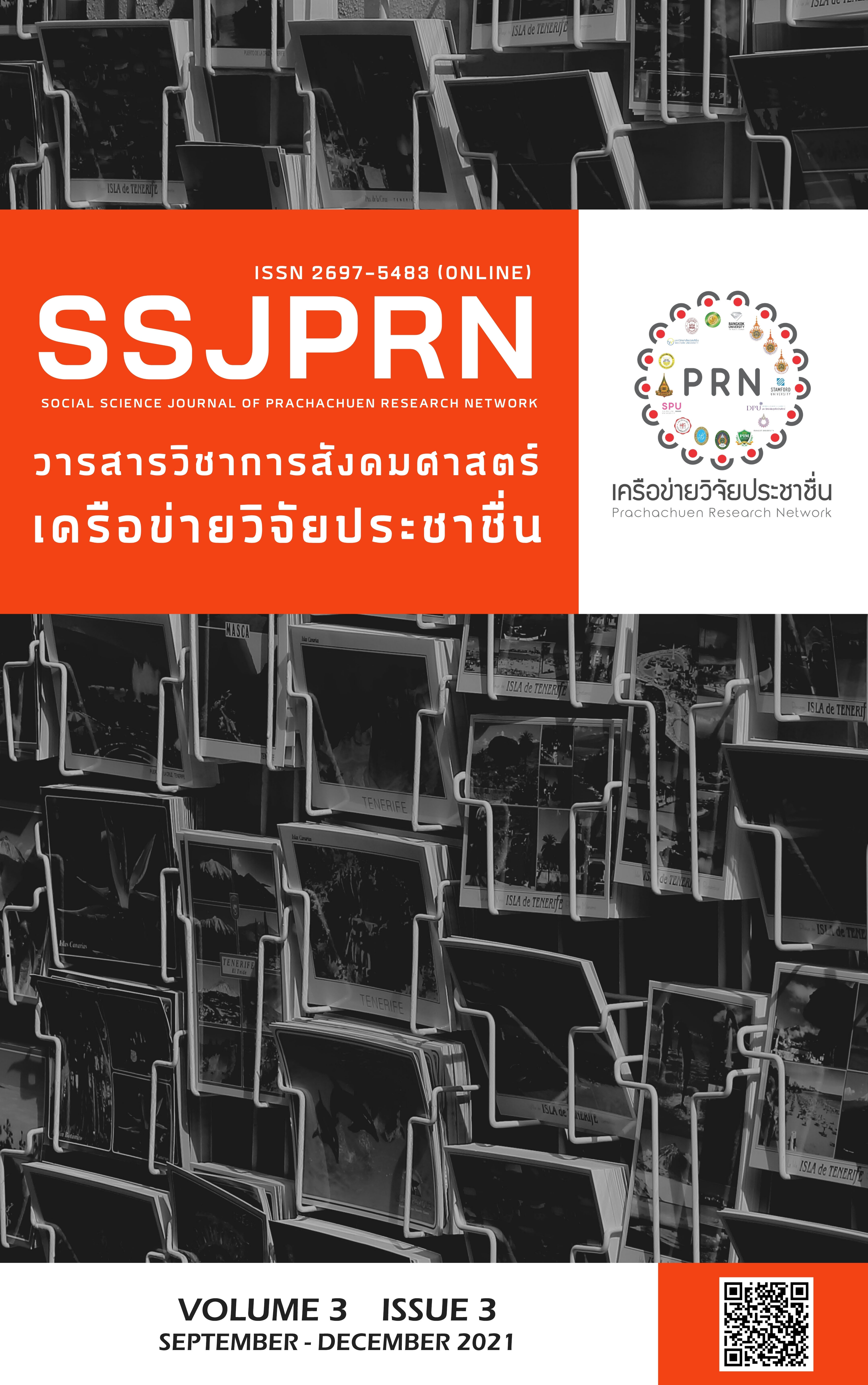การศึกษาตัวแบบที่ส่งผลต่อความภักดีของร้านค้าปลีกออนไลน์กลุ่มร้านสะดวกซื้อ ห้างสรรพสินค้า และซุปเปอร์มาร์เก็ต
คำสำคัญ:
การรับรู้, การตระหนักรู้, ความเชื่อใจ, ความภักดี, ร้านค้าปลีกออนไลน์บทคัดย่อ
การวิจัยนี้มีวัตถุประสงค์เพื่อศึกษาความสัมพันธ์เชิงเหตุผลระหว่างการรับรู้ การตระหนักรู้ และความเชื่อใจที่มีผลต่อความภักดีร้านค้าปลีกออนไลน์ประเภทการค้าปลีกสมัยใหม่ และเพื่อศึกษารูปแบบการรับรู้ การตระหนักรู้ และความเชื่อใจที่ส่งผลต่อความภักดีร้านค้าออนไลน์ประเภทการค้าปลีกสมัยใหม่ ทำการเก็บข้อมูลกับผู้บริโภคออนไลน์ที่ซื้อสินค้าในร้านค้าปลีกทั้ง 3 กลุ่มประกอบด้วยกลุ่มร้านสะดวกซื้อ ห้างสรรพสินค้า และซุปเปอร์มาร์เก็ต จำนวน 300 คน โดยใช้การวิเคราะห์ข้อมูลทางสถิติ การแจกแจงความถี่ ค่าร้อยละ ค่าเฉลี่ยเลขคณิต ค่าส่วนเบี่ยงเบนมาตรฐาน และเทคนิคการวิเคราะห์โมเดลสมการโครงสร้าง
ผลการตรวจสอบดัชนีชี้วัดความเหมาะสมของรูปแบบ พบว่า ค่าไคสแคว์มีค่า = 367.862,
/df = 2.452, และดัชนี GFI = 0.917, RMSEA = 0.059, RMR = 0.043, CFI = 0.963, และ AGFI = 0.884 มีค่าผ่านเกณฑ์ที่กำหนด ผลการศึกษาของความสัมพันธ์เชิงเหตุผล พบว่า การรับรู้ของผู้บริโภคในธุรกิจค้าปลีกออนไลน์มีผลต่อการตระหนักรู้ (p-value = 0.000) และความเชื่อใจ (p-value = 0.000) ในขณะที่ความเชื่อใจของผู้บริโภคในธุรกิจค้าปลีกออนไลน์มีผลต่อความภักดี (p-value = 0.008)
เอกสารอ้างอิง
ชิตชัย เธียรกาญจนวงค์. (2555). ไทยโพสต์. สืบค้นจาก https://www.thaipost.net/main/detail/17612.
ธนาคารกรุงศรีอยุธยา จำกัด (มหาชน). (2564). การวิเคราะห์ธุรกิจ. สืบค้นจาก https://www.krungsri.com/th/research/home.
ภาวิณี ทองแย้ม. (2560). องค์ประกอบสำคัญที่มีผลต่อความจงรักภักดีของลูกค้าไฮเปอร์มาร์เก็ต ในกรุงเทพมหานครบนตัวแบบเส้นทางกำลังสองน้อยที่สุด. วารสารบริหารธุรกิจเทคโนโลยีมหานคร, 14(1), 241-254.
สุภัตรา แปงการิยา และ สุมาลี สว่าง. (2561). ปัจจัยการรับรู้คุณค่าที่ลูกค้าได้รับและปัจจัยคุณภาพ ความสัมพันธ์ที่ ส่งผลต่อความภักดีของลูกค้าร้านขายยาในประเทศไทย. เศรษฐศาสตร์และบริหารธุรกิจปริทัศน์, 14(1), 20.
อัมพล ชูสนุก และ คณะ. (2560). อิทธิพลของคุณภาพการให้บริการต่อคุณค่าที่รับรู้ ความพึงพอใจ และความจงรักภักดีของผู้ใช้บริการคลินิกเสริมความงามในเขตกรุงเทพมหานคร. วารสารอิเล็กทรอนิกส์ Veridian มหาวิทยาลัยศิลปากร (มนุษยศาสตร์สังคมศาสตร์และศิลปะ), 9(1), 1565-1584.
อิทธิวัฒน์ รัตนพองบู่. (2555). E-Marketing การตลาดออนไลน์. กรุงเทพฯ : H.N. Group.
Aaker, D. A. (1991). Managing brand equity: Capitalization the value of a brand name. New York: Free.
Aaker, D. A. (1996). Building Strong Brand. London: Simon & Schuster.
Ahmad, Z., Jun, M., Khan, I., Abdullah M., & Ghauri, T. A. (2016). Examining Mediating Role of Customer Loyalty for Influence of Brand Related Attributes on Customer Repurchase Intention. Journal of Northeast Agricultural University, 23(2), 89-96.
Bilal, A., & Malik F. M. (2014). Impact of Brand Equity & Brand Awareness on Customer’s Satisfaction. International Journal of Modern Management & Foresight, 1(10), 287-303.
Chahal, H., & Rani, A. (2017). How trust moderates social media engagement and brand equity. Journal of Research in Interactive Marketing, 11(3), 312-335.
Chen, C.-C.V., & Chen, C.-J. (2017). The role of customer participation for enhancing repurchase intention. Management Decision, 55(3), 547-562. https://doi.org/10.1108/MD-06-2016-0380
Conbach, L. Joseph. (1984). Essential of Psychology and Education. New York: Mc–Graw Hill.
Hair, J. F., & et al. (2010). Multivariate Data Analysis. Seventh Edition. Prentice Hall, Upper Saddle River, New Jersey.
Ismail, A., Nguyen, B., & Melewar, T. (2018). Impact of perceived social media marketing activities on brand-and value consciousness: Roles of usage, materialism and conspicuous consumption. International Journal of Internet Marketing and Advertising, 12(3), 233–254.
Keller, K. L. (2008). Strategic brand management: Building, measuring and managing brand equity (3rd ed.). UpperSaddle River, NJ: PearsonPrentice Hall.
Kiumarsi, S., Krishnaswamy, J., & Isa, S. M. (2015). Service quality and innovation in Malaysian post offices: An empirical study. Global Business and Organizational Excellence, 35(1), 55–66.
Kotler, P., & Armstrong, G. (2017). Principles of Marketing (17th ed., Global Ed.). Harlow: Pearson.
Kotler, P., & Keller, K. L. (2012). Marketing management: The millennium (14th ed.) New Jersey: Prentice-Hall Inc.
Kuo-Chien Chang., Mu-Chen Chen., Chia-Lin Hsu., & Nien-Te Kuo. (2010). The effect of service convenience on post-purchasing behaviours. Industrial Management & Data Systems, 110(9), 1420-1443.
Lassoued, R., & Hobbs, J. E. (2015). Consumer confidence in credence attributes: The role of brand trust. Food Policy, 52(1), 99-107.
Lin, C., & Lekhawipat, W. (2014). Factors affecting online repurchase intention. Industrial Management & Data Systems, 114(4), 597-611.
Mohammad, R. H., Michel, L., & Marie, O. R. (2014). The roles of brand community and community engagement in building brand trust on social media. Computers in Human Behavior, 37(1), 152-161.
Mudzakkir, M. F., & Nurfaida, I. N. (2015). The Influence on Brand Awareness on Brand Trust through Brand Image. Proceeding of International Conference on Accounting, Business & Economics (pp. 609-615). Yogyakarta: Indonesia. Retrieved from https://www.researchgate.net/publication/314460821_The_Influence_of_Brand_Awareness_on_Brand_Trust_Through_Brand_Image.
Oliver, R. L. (1997). Satisfaction: A Behavioral Perspective on the Consumer. McGraw-Hill, New York.
Riasma, D. K. P., Rahyuda, K., & Yasa, N. N. K. (2018). The Role of Satisfaction and Trust in Mediating The Relationship of Brand Experience and Loyalty. International Journal of Economics, Commerce and Management, 4(1), 66-77.
See-To, E. W., & Ho, K. K. (2014). Value co-creation and purchase intention in social network sites: The role of electronic Word-of-Mouth and trust–A theoretical analysis. Computers in Human Behavior, 31, 182-189.
Weiss, R., Feinstein, A. H., & Dalbor, M. (2005). Customer satisfaction of theme restaurant attributes and their influence on return intent. Journal of Foodservice Business Research, 7(1), 23-41.
ดาวน์โหลด
เผยแพร่แล้ว
รูปแบบการอ้างอิง
ฉบับ
ประเภทบทความ
สัญญาอนุญาต
บทความที่ได้รับการตีพิมพ์เป็นลิขสิทธิ์ของวารสารวิชาการสังคมศาสตร์เครือข่ายวิจัยประชาชื่น







